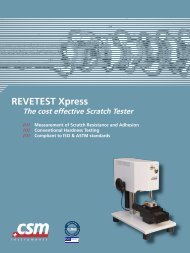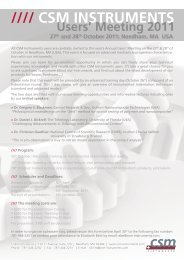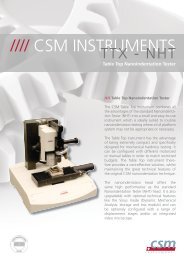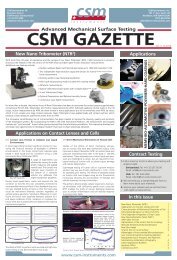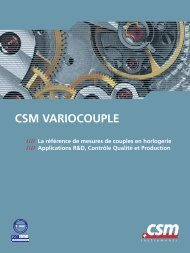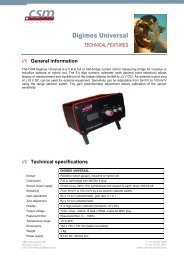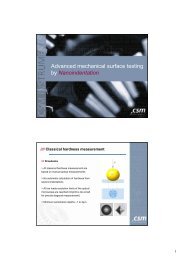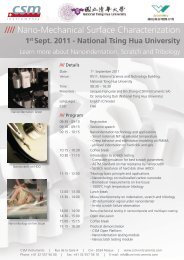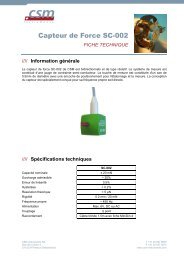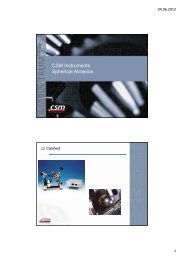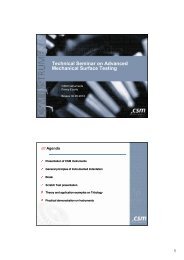Instrumented Indentation - CSM Instruments
Instrumented Indentation - CSM Instruments
Instrumented Indentation - CSM Instruments
Create successful ePaper yourself
Turn your PDF publications into a flip-book with our unique Google optimized e-Paper software.
Advanced mechanical surface testing by<br />
Nanoindentation<br />
Technical Workshop<br />
Brescia, 17.04.2012<br />
Fanny Ecarla
Agenda<br />
Introduction –<br />
Classical Hardness vs<br />
Principle of <strong>Instrumented</strong> <strong>Indentation</strong><br />
<strong>Instrumented</strong> <strong>Indentation</strong><br />
Advance measuring modes, analysis and challenges of<br />
<strong>Instrumented</strong> <strong>Indentation</strong><br />
Key features of <strong>CSM</strong> <strong>Indentation</strong> Tester – Surface Top<br />
Referencing
Classical hardness measurement<br />
//// Drawbacks<br />
> All classical hardness measurement are<br />
based on manual optical measurements<br />
> No automatic calculation of hardness from<br />
several indentations<br />
> At low loads resolution limits of the optical<br />
microscope are reached (imprint is too small<br />
for precise diagonal measurement)<br />
> Minimum penetration depths �1 to 2�m
Principle of <strong>Instrumented</strong> <strong>Indentation</strong>
Why the Nanoindentation?<br />
> On a surface covered by thin layers, the<br />
maximum depth of the indentation must be<br />
lower than 10% of total depth of the<br />
covering<br />
substrate.<br />
to avoid influence on the<br />
Film depth, h film<br />
Maximum penetration, h m<br />
Elastic distortion<br />
h<br />
h<br />
m �<br />
film<br />
10%<br />
> High resolution positioning:<br />
- Small volume testing<br />
- High positioning accuracy<br />
10�m
What is the <strong>Instrumented</strong> <strong>Indentation</strong><br />
> Instrument which provides the ability to measure the indenter depth<br />
penetration, h, under the applied force, F, throughout the testing<br />
cycle.<br />
> It is capable of measuring both the plastic and elastic deformation of<br />
the material under test.<br />
F<br />
N<br />
Sample<br />
XY Table<br />
Load Actuator<br />
(coil/magnet)<br />
Displacement Sensor<br />
(capacitive gauge or LVDT)<br />
Reference
<strong>Instrumented</strong> indentation: not only hardness<br />
//// Information revealed from Nanoindentation Testing:<br />
> Hardness (instrumented, recalculated Vickers hardness)<br />
> Elastic modulus<br />
> Storage & loss modulus (polymers)<br />
- Depth profiles (hardness, Elastic modulus, storage & loss modulus)<br />
> Elastic/plastic energy ratio (measure of elasticity)<br />
> Fracture toughness (brittle materials)<br />
> Creep<br />
> Stress-strain curves (analogy to tension tests)<br />
> …etc.
<strong>Indentation</strong> Tips<br />
Berkovich (142.3°)<br />
Conical (R < 3 µm)<br />
Vickers (136°)<br />
Cube Corner (90°)<br />
Conical (R > 3 µm)
Pyramid indenters<br />
Projected contact area For pyramidal indenters<br />
A p<br />
(vickers) = Ap (berkovich)<br />
Same h
Load-Displacement Data<br />
Comparison of elastic, perfectly plastic, and elastic-plastic<br />
contact characteristics<br />
Stress-Strain<br />
curves<br />
<strong>Indentation</strong><br />
curves<br />
<strong>Indentation</strong><br />
prints<br />
�<br />
F<br />
Elastic<br />
�<br />
h<br />
�<br />
F<br />
Plastic Elastic - Plastic<br />
�<br />
h<br />
�<br />
F<br />
�<br />
h
Calculation of Hardness (H IT )<br />
The maximum applied force Fm is obtained by the load and unload<br />
curves<br />
The projected contact area is established by the contact point.<br />
Hardness �<br />
H �<br />
IT<br />
Fm<br />
Ap<br />
F m<br />
Applied Load<br />
Depth
Calculation of Elastic Modulus (E IT )<br />
> Similar procedure as for hardness calculation:<br />
1. fit of the loading/unloading curve<br />
2. determination of the slope S<br />
3. determination of the contact depth h c (the depth<br />
corresponding to contact of the material with the<br />
indenter, not the maximum depth)<br />
4. calculation of projected contact area A p at contact<br />
depth<br />
5. calculation of reduced modulus E*<br />
6. knowing Elastic modulus of the indenter<br />
(diamond) we can calculate Elastic modulus of the<br />
coating EIT Reduced modulus<br />
*<br />
E<br />
IT<br />
�<br />
π<br />
2<br />
S<br />
A p<br />
S stiffness<br />
Ap projected contact area<br />
Eit, � Elastic modulus/Poisson’s ratio of the coating<br />
Ei, �i Elastic modulus/Poisson’s ratio of the indenter<br />
F m<br />
Load, F<br />
Depth<br />
, h<br />
E<br />
it<br />
*<br />
it<br />
h<br />
p<br />
h<br />
r<br />
hs =<br />
�.(hm–hr h<br />
2<br />
1��<br />
�<br />
2<br />
1 1��<br />
� i<br />
E E<br />
c<br />
S<br />
Elastic modulus (E IT )<br />
i<br />
)<br />
h<br />
m
Experimental procedure<br />
F m<br />
Measure F m and h t<br />
Calculate<br />
Hardness<br />
Calculate<br />
Reduced<br />
Modulus<br />
E<br />
*<br />
IT<br />
h t<br />
F<br />
HIT �<br />
A<br />
�<br />
�<br />
2<br />
m<br />
p<br />
S<br />
A<br />
p<br />
Calculate<br />
Modulus<br />
F m<br />
1<br />
E<br />
*<br />
IT<br />
A<br />
p<br />
�<br />
0<br />
2<br />
c<br />
1<br />
2<br />
h<br />
c<br />
�<br />
h<br />
t<br />
Fm<br />
� �<br />
S<br />
Calculate<br />
Contact Depth<br />
� C h � C hc<br />
� C hc<br />
� C hc<br />
Calculate Projected Area of Contact<br />
( 1<br />
2<br />
� � ) ( 1 � �<br />
�<br />
E<br />
E IT<br />
S<br />
ht Calculate Stiffness<br />
i<br />
2<br />
i<br />
)<br />
1<br />
2<br />
3<br />
1<br />
4<br />
� ...
Advanced modes and analysis
<strong>Indentation</strong> Software<br />
Load<br />
Type of test<br />
Standard Multicycle CMC Sinus<br />
Time<br />
Type of array<br />
Load<br />
Time<br />
Simple Line Matrix<br />
Load<br />
Time<br />
Load<br />
Time
<strong>Indentation</strong> Software<br />
Standard test<br />
One <strong>Indentation</strong><br />
One measure of H IT & E IT<br />
Load<br />
Time
<strong>Indentation</strong> Software<br />
CMC (Continuous Multi Cycle)<br />
Each cycle gives H IT and E IT<br />
Load<br />
Time<br />
Same position<br />
Increasing load at each cycle
<strong>Indentation</strong> Software<br />
Sinus (DMA)<br />
Load<br />
Time
Dynamic Mechanical Analysis:<br />
Sinus Mode<br />
Force<br />
A small amplitude force oscillation is superimposed onto the<br />
applied load signal and the resultant displacement amplitude<br />
measured. This method is very useful in revealing information<br />
about storage and loss modulus.<br />
Time<br />
Force<br />
Time
Dynamic Mechanical Analysis: Sinus Mode<br />
The viscous character of the material introduces a phase angle<br />
φ between the force and displacement signals:<br />
ho<br />
Force<br />
�<br />
Time<br />
ho<br />
Displacement
Visual Matrix
Visual <strong>Indentation</strong><br />
Direct calculation of hardness from the loading / unloading curve:<br />
possibility of automated measurements<br />
(matrix/advanced visual matrix)<br />
No need for optical measurement of dimension of the imprint<br />
Directly measured penetration depth: to avoid influence by the<br />
substrate
Fracture Toughness<br />
Pure Silicon<br />
K<br />
1<br />
�<br />
� � E<br />
� �<br />
� �<br />
�<br />
� � H<br />
IT<br />
IT<br />
�<br />
�<br />
�<br />
�<br />
1/<br />
2<br />
�<br />
�<br />
� P<br />
�<br />
��<br />
��<br />
c<br />
3<br />
2<br />
�<br />
�<br />
�<br />
�<br />
TiN on 440C steel<br />
c
Creep<br />
><br />
><br />
Force, F [mN]<br />
In an indentation test, creep often manifests itself as a bowing out<br />
or “nose” in the unloading portion of the force-displacement curve.<br />
For such material, when the force is held during a certain time at<br />
the maximum force, the indenter continues to penetrate.<br />
1.2<br />
0.8<br />
0.4<br />
0<br />
Hold period of 120s<br />
No hold period<br />
0 200 400 600<br />
<strong>Indentation</strong> depth, h [nm]<br />
Nose<br />
PMMA 1mN force<br />
Loading rate 2mN/min
Influence of Surface Roughness
Influence of Surface Roughness<br />
><br />
><br />
Surface roughness is extremely important in <strong>Instrumented</strong><br />
<strong>Indentation</strong> Testing because mechanical properties of the<br />
tested material are calculated on the assumption that the<br />
sample surface is flat.<br />
Because the IIT technique uses the measured indentation<br />
depth to estimate the residual contact area and subsequently<br />
calculate the hardness, the surface roughness can have a<br />
significant influence on the resultant values.
><br />
//// Influence of Surface Roughness<br />
When the indenter comes into contact with a peak, the non-uniform<br />
contact increases the localized stress at the points of contact,<br />
deforming the material to a greater depth at relatively low loads.<br />
This can result in a greater penetration depth and lower calculated<br />
hardness.<br />
When the indenter comes into contact with a valley, the true<br />
contact area is underestimated and consequently, the calculated<br />
hardness is overestimated.
Influence of Surface Roughness<br />
Ra=5nm<br />
Ra=167nm
Influence of Surface Roughness<br />
><br />
><br />
It is imperative to know the condition of a surface before<br />
proceeding with an instrumented indentation test.<br />
The International Standard ISO 14577-4 stipulated that the Ra<br />
value should be less than 5% of the maximum penetration<br />
depth.
Influence of Surface Roughness
Nanoindentation in Liquid
Nanoindentation in Liquid<br />
Simple NHT modification for in-situ liquid testing<br />
All NHT technical specifications are maintained
Nanoindentation in Liquid<br />
Standard NHT<br />
Modified NHT<br />
NOTE: The holes in the extension allow liquid to circulate around indenter without any<br />
risk of entering the head
Key Features of <strong>CSM</strong> <strong>Indentation</strong> Testers<br />
Top Surface Referencing
<strong>Instrumented</strong> <strong>Indentation</strong><br />
General Principle<br />
F N<br />
Sample<br />
XY Tables<br />
Load Actuator<br />
(coil/magnet or<br />
Electrostatic)<br />
Displacement Sensor<br />
(capacitive gauge or LVDT)
<strong>Instrumented</strong> <strong>Indentation</strong><br />
Thermal drift<br />
Depth variation
<strong>Instrumented</strong> <strong>Indentation</strong><br />
Table play, sample drift or compression<br />
Depth variation
<strong>CSM</strong> <strong>Indentation</strong>: <strong>Instrumented</strong> <strong>Indentation</strong><br />
<strong>CSM</strong> Principle<br />
F N<br />
Sample<br />
XY Tables<br />
Load Actuator<br />
(coil/magnet)<br />
Displacement Sensor<br />
(capacitive gauge or LVDT)<br />
Reference (ring or fork)
<strong>CSM</strong> Principle<br />
Thermal drift<br />
Depth stable
<strong>CSM</strong> Principle<br />
Table play, sample drift or compression<br />
Depth stable
Top Referencing<br />
Effective compliant material is of the order of a few millimeters in<br />
length, between the surface and the depth sensor<br />
6 mm<br />
Sample
Top Referencing<br />
The reduction in the length of the compliant material between<br />
the surface and the depth sensor leads to greater accuracy in<br />
the measurement.<br />
Sample
<strong>CSM</strong> Nanoindentation<br />
Unique referencing technique by <strong>CSM</strong> <strong>Instruments</strong><br />
> Unique thermal stability<br />
> High Throughput<br />
> Reliability<br />
> Functionalities<br />
> The most easy-to-use nanoindentation system
Ultra Nanoindentation Tester
FN<br />
Ultra Nanoindentation Tester (UNHT)<br />
Feedback loop<br />
on force sensor<br />
Load-depth curve<br />
Dz<br />
Indenter Loading Unloading Contact<br />
A1<br />
I<br />
sample<br />
Stage<br />
A2<br />
R<br />
A1 & A2:<br />
piezoelectric<br />
actuators<br />
Reference contact<br />
Motorized<br />
Feedback loop<br />
for accurate low<br />
force sensing<br />
Z table
<strong>Indentation</strong> depth, h [nm]<br />
UNHT Stability During Measurement<br />
h [nm]<br />
91<br />
90<br />
89<br />
100<br />
80<br />
60<br />
40<br />
20<br />
0<br />
33 83 133 183 233 283 333<br />
Time, t [s]<br />
0 50 100 150 200 250 300 350<br />
Time, t [s]<br />
Fused Silica 1mN force<br />
1.5<br />
1.2<br />
0.9<br />
0.6<br />
0.3<br />
0<br />
Depth variation<br />
less than 1nm<br />
over 5 minutes<br />
Force, F [mN]
Force (µN)<br />
120<br />
100<br />
80<br />
60<br />
40<br />
20<br />
0<br />
5 nm indentation on DLC film<br />
Noise floor less than 0.1 nm!<br />
Single Indent<br />
0 1 2 3 4 5 6<br />
Pentration Depth (nm)
Thank you for your attention




